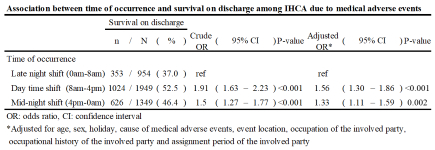Final ID: Sa904
Relationship between time of occurrence and survival of in-hospital cardiac arrests triggered by medical adverse events(Nationwide medical adverse events database in Japan)
Abstract Body: [Background]
The outcome of in-hospital cardiac arrest (IHCA) has improved over the past decade, although the survival rate is still approximately 25%. Some cases of IHCA are triggered by medical adverse events, and their outcomes might be different by time when how many staffs is available. But the relationship between the time of occurrence and outcome remains unclear. The aim of this study is to compare the survival outcomes of IHCA at night with those during the daytime using the nationwide medical adverse events database in Japan.
[Methods]
We searched the Japan Council for Quality Health Care nationwide in-hospital adverse events database, which registered 1 million cases per year, from 2010 to 2023. We extracted cases of IHCA and analyzed the cases by time of occurrence, grouping them into day time shift (8am-4pm), midnight shift (4pm-0am), and late night shift (0am-8am). The primary outcome was survival to discharge, and we performed multivariate logistic regression to adjust for age, sex, holiday, cause of medical adverse events, event location, occupation of the involved party, occupational history of the involved party and assignment period of the involved party as potential confounders.
[Result]
A total of 4,252 cases were included during the study period. The most common age group was over 70years old (54.2%, n = 2,303 /4,252). 2,627 patients (61.8%) were male. The number of IHCA per time period was 1949 (45.8%) in the day time shift, 1,349 (31.7%) in the midnight shift and 954 (22.4%) in the late night shift. The most common cause of medical adverse events in all time periods was treatment or procedures. However, the rate of medical care was higher in the late night shift. Regarding the location of the event, the general ward was the most common location at all times. Multivariate logistic regression for survival on discharge yielded an adjusted odds ratio of 1.56 (95% confidence interval [CI]: 1.30–1.86) ,1.33 (95% CI: 1.11–1.59) for the day time shift and midnight shift compared to the late night shift.
[Conclusion]
Approximately 20% of in-hospital cardiac arrests due to medical adverse events occurred on the late night shift, with poor outcomes. Time of occurrence was associated with survival to discharge among IHCA cases that were identified in the nation-wide adverse events database.
The outcome of in-hospital cardiac arrest (IHCA) has improved over the past decade, although the survival rate is still approximately 25%. Some cases of IHCA are triggered by medical adverse events, and their outcomes might be different by time when how many staffs is available. But the relationship between the time of occurrence and outcome remains unclear. The aim of this study is to compare the survival outcomes of IHCA at night with those during the daytime using the nationwide medical adverse events database in Japan.
[Methods]
We searched the Japan Council for Quality Health Care nationwide in-hospital adverse events database, which registered 1 million cases per year, from 2010 to 2023. We extracted cases of IHCA and analyzed the cases by time of occurrence, grouping them into day time shift (8am-4pm), midnight shift (4pm-0am), and late night shift (0am-8am). The primary outcome was survival to discharge, and we performed multivariate logistic regression to adjust for age, sex, holiday, cause of medical adverse events, event location, occupation of the involved party, occupational history of the involved party and assignment period of the involved party as potential confounders.
[Result]
A total of 4,252 cases were included during the study period. The most common age group was over 70years old (54.2%, n = 2,303 /4,252). 2,627 patients (61.8%) were male. The number of IHCA per time period was 1949 (45.8%) in the day time shift, 1,349 (31.7%) in the midnight shift and 954 (22.4%) in the late night shift. The most common cause of medical adverse events in all time periods was treatment or procedures. However, the rate of medical care was higher in the late night shift. Regarding the location of the event, the general ward was the most common location at all times. Multivariate logistic regression for survival on discharge yielded an adjusted odds ratio of 1.56 (95% confidence interval [CI]: 1.30–1.86) ,1.33 (95% CI: 1.11–1.59) for the day time shift and midnight shift compared to the late night shift.
[Conclusion]
Approximately 20% of in-hospital cardiac arrests due to medical adverse events occurred on the late night shift, with poor outcomes. Time of occurrence was associated with survival to discharge among IHCA cases that were identified in the nation-wide adverse events database.
More abstracts on this topic:
A Predictive Score for In-Transit Cardiac Arrest in Trauma Patients: Development and Validation Using a National Registry
Nishida Tsubasa, Nishikimi Mitsuaki, Namba Takeshi, Ohshimo Shinichiro, Shime Nobuaki
A Multicentre Study for Hands Only CPR (HOCPR) training assessment towards building a ‘Nation of Life Savers” in IndiaRavikumar Thanjavur, Sarma Kvs, Ravikumar Thanjavur, Sarkar Manuj, Debnath Dhrubajyoti, Behera Priyamadhaba, Ghate Jayshri, Trikha Divay, Samantaray A, Madhavi K

